Valorization of Historical Urban Spaces for Managed Aquifer Recharge as a Tool to Support Sustainable Urban Development in Warsaw, Poland
Abstract
1. Introduction
2. Material and Methods
2.1. Study Area
2.1.1. Geological Structure
2.1.2. Hydrogeological Conditions
2.2. Methods
2.2.1. Climate Data Analysis
2.2.2. Direct Tests in the Vadose Zone
2.2.3. Spring Research
2.2.4. Groundwater Modeling
- east: along the Vistula,
- north, west, south: artificial boundaries along major streets.
- recharge and evaporation rate from the groundwater table in places where it is shallow,
- groundwater inflow from the south and through the boundary (lateral inflow to aquifers),
- direct drainage by the Vistula river,
- lateral outflow of groundwater to the north.
- first: shallow aquifer,
- second: glacial tills, clays, and silts as an aquitard layer, in the Vistula valley this level disappears, and the shallow and deeper aquifer are merged,
- third: Quaternary, deeper aquifer.
2.2.5. A Valorization of the Study Area for Temporary Retention of Rainwater in the Vadose Zone
- Data from the numerical flow model: depth of groundwater occurrence in the first aquifer, where the greater thickness of the vadose zone allows underground retention facilities to be sited without the risk of overflowing due to lack of drainage into the ground; magnitude of infiltration recharge—where the occurrence of areas of low recharge allows additional water to be introduced; hydraulic conductivity—where the occurrence of areas of high permeability also allows rapid infiltration into the water table;
- Field observations in the vadose zone: vadose zone moisture content—preferred areas for the location of retention facilities where moisture content during the rain-free period was lowest; soil electrical conductivity—preferred areas where the EC of the soil solution was lowest immediately after snowmelt, meaning that conditions in the soil profile were favorable for infiltration;
- Data from the DEM [26]: artificial catchment area—based on the location of combined sewer manholes, larger catchments were prioritized to maximize runoff reduction; slope—an inverse slope procedure was used to identify the areas with the least slope that would be preferred for the location of retention facilities;
- Land use data from satellite imagery and field observations (Airbus, CNES/Airbus, MGGP Aero, Maxar Technologies (Westminster, CO, USA), Data Maps, Google, 2023): land use—the procedure for preparing the layer consisted in identifying the areas where retention facilities cannot be located, so buildings were excluded from the analysis, their immediate vicinity up to 3 m and areas up to 5 m from trees were considered the least desirable, while the remaining green areas were considered less preferable for location than pavements and asphalt surfaces, under which the provision of an adequate foundation depth guarantees the protection of the facilities from the impact of static and dynamic stresses on the ground surface.
2.2.6. Soakaway Crates
3. Results
3.1. Climate Data Analysis
3.2. Direct Tests in the Vadose Zone
3.3. Spring Research
3.4. Groundwater Model
3.5. Space Valorization Results
3.6. Location of Retention Facilities
3.7. Mapping Managed Aquifer Recharge on a Groundwater Model
4. Discussion
5. Conclusions
Author Contributions
Funding
Data Availability Statement
Acknowledgments
Conflicts of Interest
References
- Kleerekoper, L.; van Esch, M.; Salcedo, T.B. How to Make a City Climate-Proof, Addressing the Urban Heat Island Effect. Resour. Conserv. Recycl. 2012, 64, 30–38. [Google Scholar] [CrossRef]
- Kuehler, E.; Hathaway, J.; Tirpak, A. Quantifying the Benefits of Urban Forest Systems as a Component of the Green Infrastructure Stormwater Treatment Network. Ecohydrology 2017, 10, e1813. [Google Scholar] [CrossRef]
- Ardalan, A.; Khaleghy Rad, M.; Hadi, M. Urban Water Issues in the Megacity of Tehran. In Urban Drought; Springer: Berlin/Heidelberg, Germany, 2019; pp. 263–288. [Google Scholar]
- Karimi, A.; Mohammad, P.; García-Martínez, A.; Moreno-Rangel, D.; Gachkar, D.; Gachkar, S. New Developments and Future Challenges in Reducing and Controlling Heat Island Effect in Urban Areas. Environ. Dev. Sustain. 2022, 25, 10485–10531. [Google Scholar] [CrossRef]
- Dąbrowski, S.; Przybyłek, J. Methodology of Test Pumping in Documenting Groundwater Resources. In Methodological Guide; Ministerstwo Środowiska: Warsaw, Poland, 2005. (In Polish) [Google Scholar]
- Jiang, C.; Li, J.; Gao, J.; Lv, P.; Zhang, Y. Quantitative Calculation of Stormwater Regulation Capacity and Collaborative Configuration of Sponge Facilities in Urban High-Density Built-up Areas. Environ. Sci. Pollut. Res. 2022, 30, 13571–13581. [Google Scholar] [CrossRef] [PubMed]
- Ahammed, F. A Review of Water-Sensitive Urban Design Technologies and Practices for Sustainable Stormwater Management. Sustain. Water Resour. Manag. 2017, 3, 269–282. [Google Scholar] [CrossRef]
- White, D.; Windsor, D. Reinvesting in History and Place to Build Resiliency and Community. In Proceedings of the Water Environment Federation, Quincy, MA, USA, 8–12 October 2022. [Google Scholar]
- Mitchell, V.G.; McMahon, T.A.; Mein, R.G. Components of the Total Water Balance of an Urban Catchment. Environ. Manag. 2003, 32, 735–746. [Google Scholar] [CrossRef] [PubMed]
- Wakode, H.B.; Baier, K.; Jha, R.; Azzam, R. Impact of Urbanization on Groundwater Recharge and Urban Water Balance for the City of Hyderabad, India. Int. Soil. Water Conserv. Res. 2018, 6, 51–62. [Google Scholar] [CrossRef]
- Brown, A.E.; Zhang, L.; McMahon, T.A.; Western, A.W.; Vertessy, R.A. A Review of Paired Catchment Studies for Determining Changes in Water Yield Resulting from Alterations in Vegetation. J. Hydrol. 2005, 310, 28–61. [Google Scholar] [CrossRef]
- Barron, O.V.; Donn, M.J.; Barr, A.D. Urbanisation and Shallow Groundwater: Predicting Changes in Catchment Hydrological Responses. Water Resour. Manag. 2013, 27, 95–115. [Google Scholar] [CrossRef]
- Martin, C.; Ruperd, Y.; Legret, M. Urban Stormwater Drainage Management: The Development of a Multicriteria Decision Aid Approach for Best Management Practices. Eur. J. Oper. Res. 2007, 181, 338–349. [Google Scholar] [CrossRef]
- Bajić, D.; Polomčić, D.; Ratković, J. Multi-Criteria Decision Analysis for the Purposes of Groundwater Control System Design. Water Resour. Manag. 2017, 31, 4759–4784. [Google Scholar] [CrossRef]
- Błażejczyk, K.; Kuchcik, M.; Milewski, P.; Szmyd, J.; Dudek, W.; Błażejczyk, A.; Kręcisz, B. Miejska Wyspa Ciepła w Warszawie; Informator: Warsaw, Poland, 2014. (In Polish) [Google Scholar]
- Sawicka, K.; Krogulec, E.; Gruszczyński, T.; Kowalczyk, S.; Małecki, J.J.; Mieszkowski, R.; Porowska, D.; Trzeciak, J.; Wojdalska, A.; Zabłocki, S.; et al. Causes of Groundwater Level and Chemistry Changes in an Urban Area; a Case Study of Warsaw, Poland. Acta Geol. Pol. 2022, 72, 495–517. [Google Scholar] [CrossRef]
- Rutkowski, H. The Beginnings of Warsaw. A Look After 700 Years; Wydawnictwo DiG: Warsaw, Poland, 2015. [Google Scholar]
- Available online: https://blizej-mieszkanca.mpwik.com.pl/#/App/Map (accessed on 23 March 2023).
- Sarnacka, Z. Detailed Geological Map of Poland in the Scale 1:50,000, Warsaw-East, Sheet No. 524; Państwowy Instytut Geologiczny: Warsaw, Poland, 1979. [Google Scholar]
- Sarnacka, Z. Explanations to Detailed Geological Map of Poland in the Scale 1:50,000, Warsaw-East, Sheet No. 524; Państwowy Instytut Geologiczny: Warsaw, Poland, 1980. [Google Scholar]
- Physiographic Atlas of the Capital City of Warsaw; Urząd m.st. Warszawy: Warsaw, Poland, 2018; Available online: https://architektura.um.warszawa.pl/-/atlas-ekofizjograficzny-warszawy (accessed on 12 September 2022).
- Kaczyński, R. Engineering-Geological Evaluation of Mio-Pliocene Clays in the Warsaw Area, Central Poland. Acta Geol. Pol. 2002, 52, 437–448. [Google Scholar]
- Cygański, K. Hydrogeological Map of Poland in the Scale 1:50,000, The Main Useful Aquifer, Warsaw-West, Sheet No. 523 with Explanations; Państwowy Instytut Geologiczny: Warsaw, Poland, 1997. [Google Scholar]
- PIG-PIB. Available online: https://baza.pgi.gov.pl/Geoportal/Geologia (accessed on 21 June 2022).
- Available online: https://danepubliczne.Imgw.pl/ (accessed on 31 March 2023).
- Available online: https://www.gov.pl/Web/Gugik (accessed on 22 August 2022).
- Available online: Https://www.geoportal.gov.pl/pl/Dane/Baza-danych-obiektow-topograficznych-bdot10k/ (accessed on 17 July 2022).
- Dębski, K. Adaptation of Konstantinov’s Nomogram to Calculations of Terrain Evaporation in Poland. In Prace i Studia Kom. Inż. I Gosp. Wodnej; Polis Academy of Science: Warsaw, Poland, 1963; Volume 6. [Google Scholar]
- Maillet, E.T. Essais d’hydraulique Souterraine & Fluviale; Librairie Scientifique, A. Hermann: Paris, France, 1905. [Google Scholar]
- Xiao, H.; Yang, Y.; Liu, Q.; Zang, Y.; Lian, X.; Xia, F.; Jiang, Y. Numerical Modeling the Impacts of Increasing Groundwater Pumping upon Discharge Decline of the BL Spring Located in Xilin Gol League in East Inner Mongolia, China. Front. Environ. Sci. 2024, 12, 1400569. [Google Scholar] [CrossRef]
- McDonald, M.; Harbaugh, A.W. A Modular Three-Dimensional Finite Difference Ground-Water Flow Model. In Techniques of Water-Resources Investigations, Book 6; U.S. Geological Survey: Washington, DC, USA, 1988; p. 588. [Google Scholar]
- Dziedziczak, R. Antropomineral Water from Warsaw Springs. Przegl. Geol. 2006, 54, 982–986. [Google Scholar]
- Maliva, R. Economics of Managed Aquifer Recharge. Water 2014, 6, 1257–1279. [Google Scholar] [CrossRef]
- Seif, A.K.; Masria, A.; Ghareeb, M.; Saleh, A.A.; Soliman, K.; Ammar, A.I. Identifying Managed Aquifer Recharge and Rain Water Harvesting Sites and Structures for Storing Non-Conventional Water Using GIS-Based Multi-Criteria Decision Analysis Approach. Appl. Water Sci. 2024, 14, 181. [Google Scholar] [CrossRef]
- Kimic, K.; Ostrysz, K. Assessment of Blue and Green Infrastructure Solutions in Shaping Urban Public Spaces—Spatial and Functional, Environmental, and Social Aspects. Sustainability 2021, 13, 11041. [Google Scholar] [CrossRef]
- Dillon, P.; Alley, W.; Zheng, Y.; Vanderzalm, J. (Eds.) Managed Aquifer Recharge: Overview and Governance; IAH Special Publication: Utrecht, The Netherlands, 2022. [Google Scholar]
- The Water Law of 2017 (Journal of Law 2017, Item 1566) in Polish. Available online: https://isap.sejm.gov.pl/ (accessed on 24 May 2025).
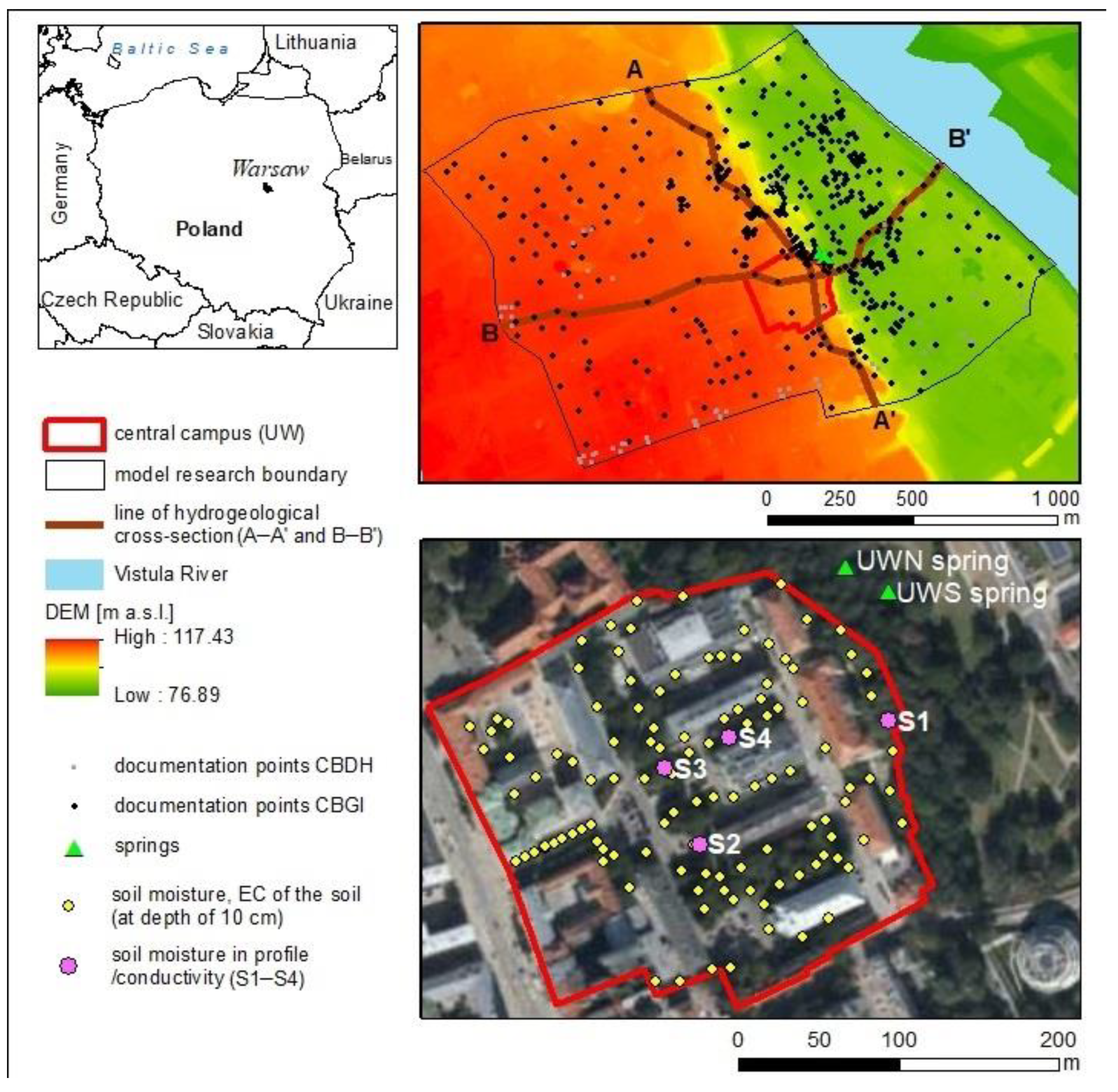

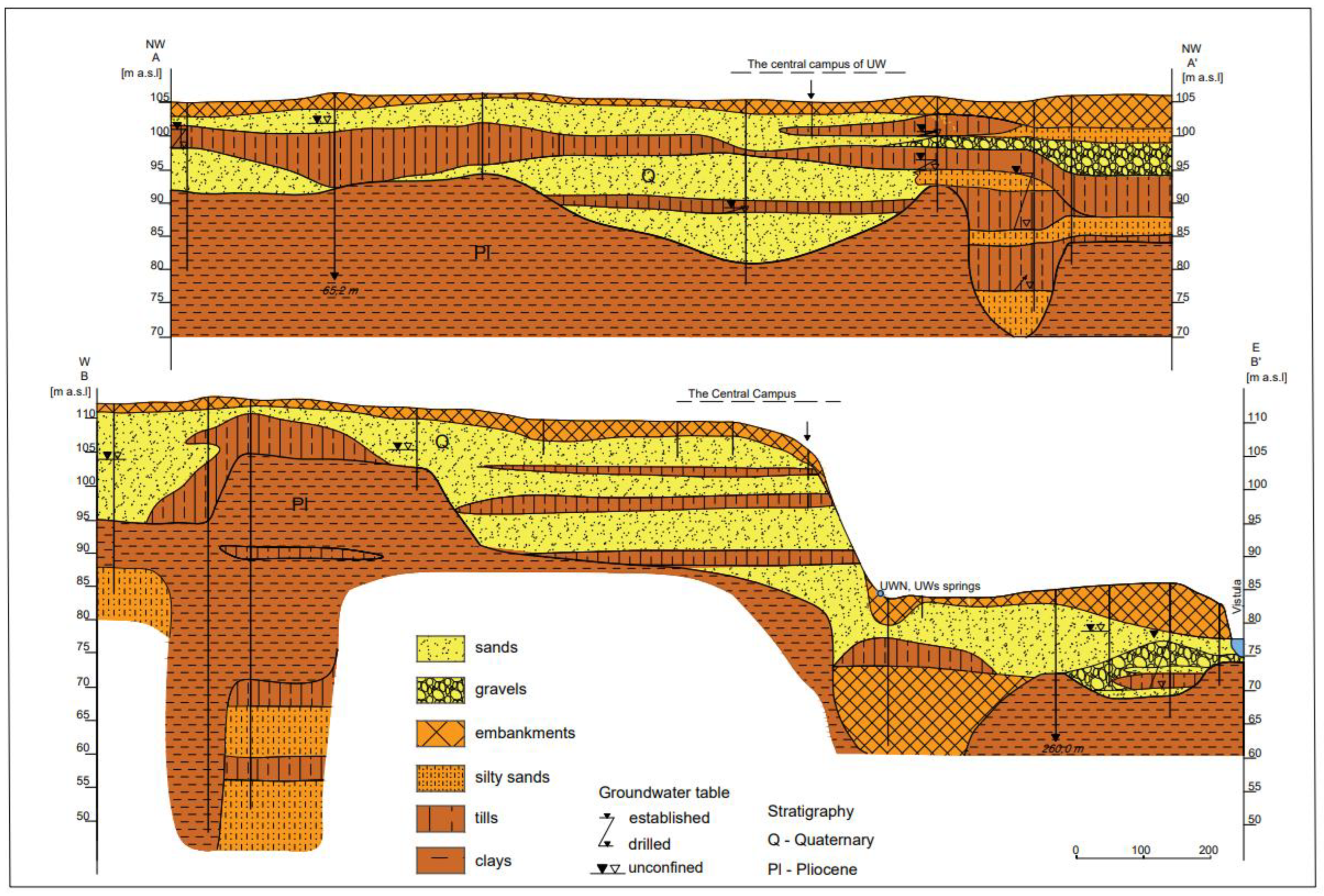

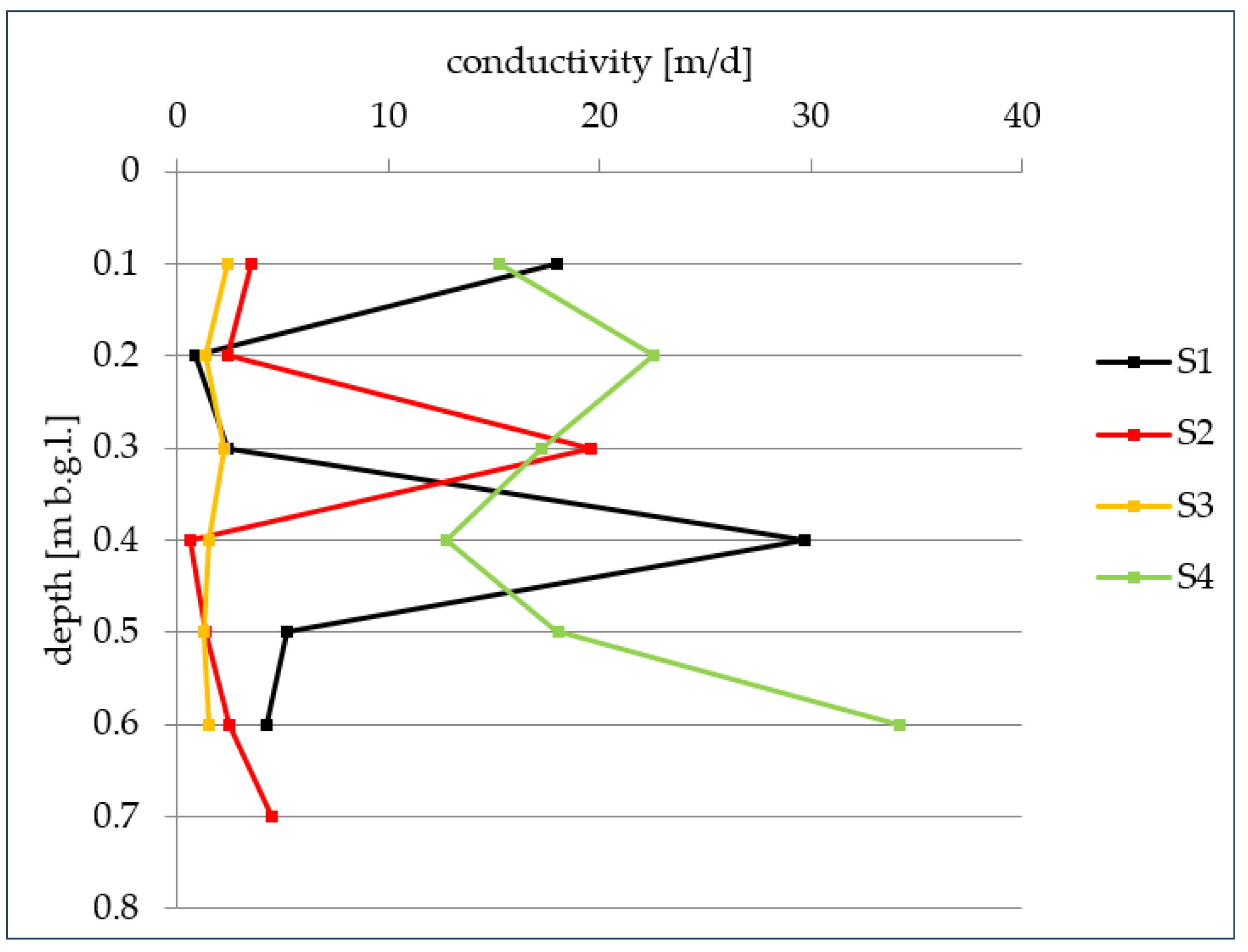

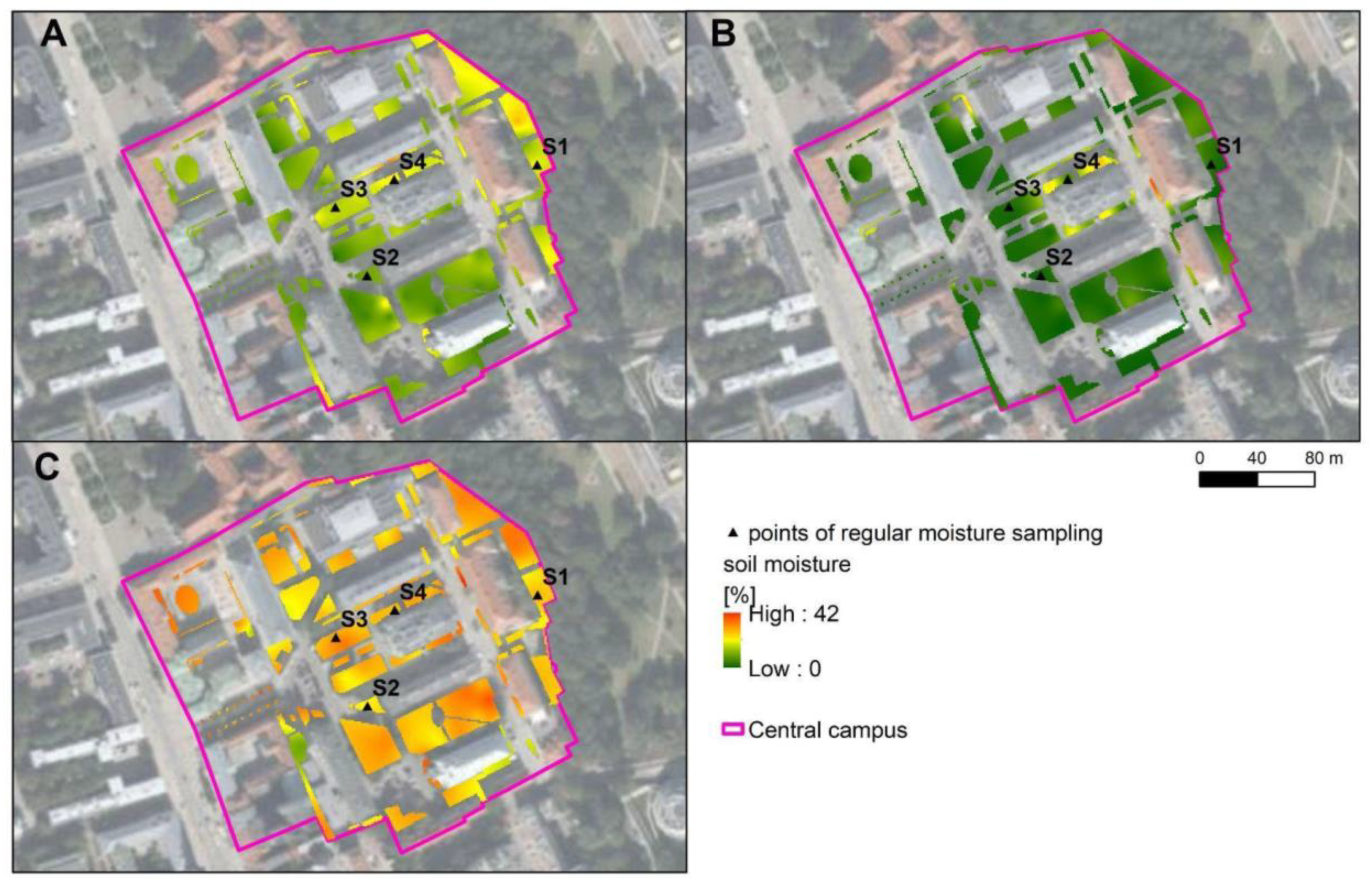
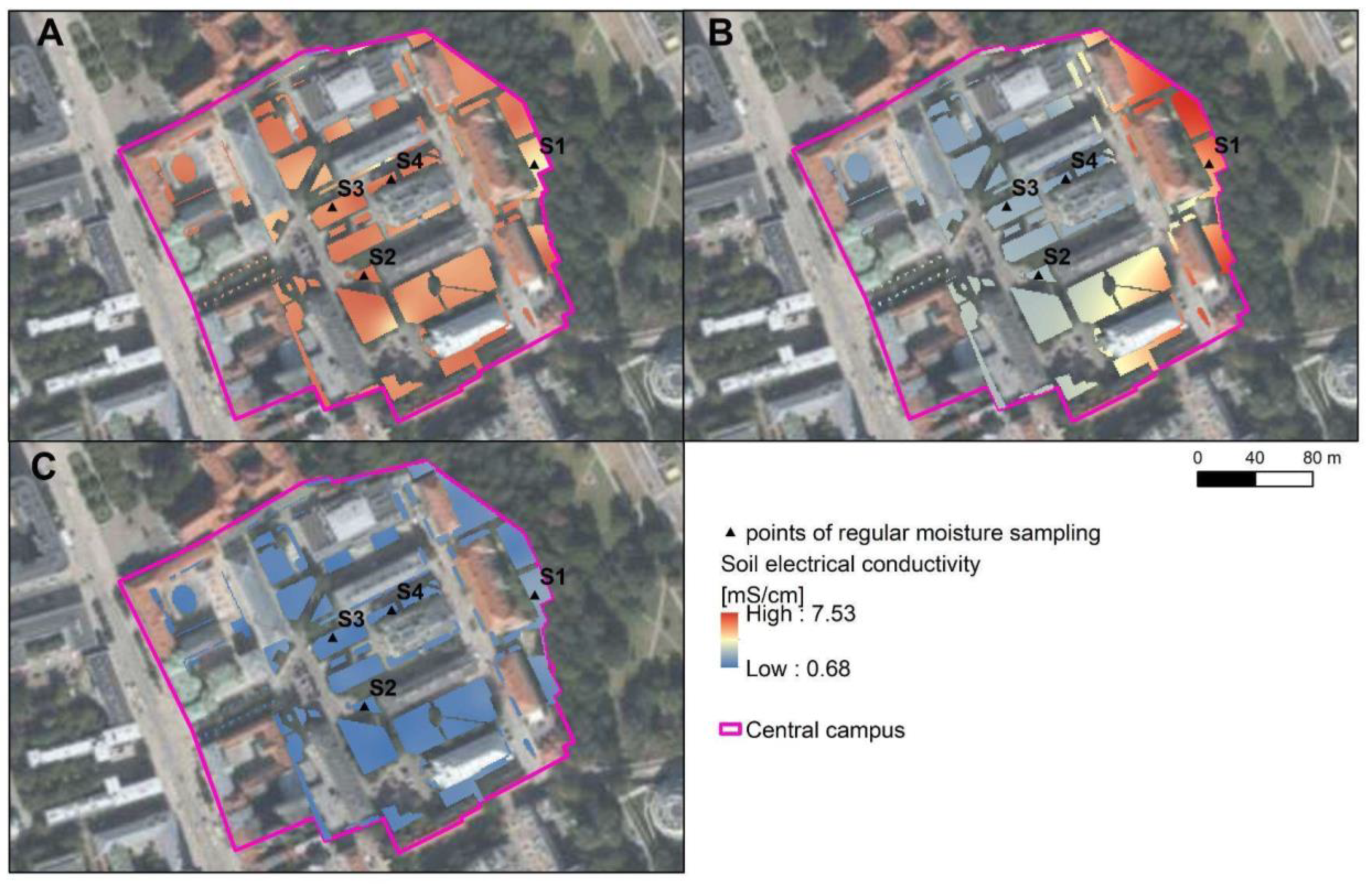
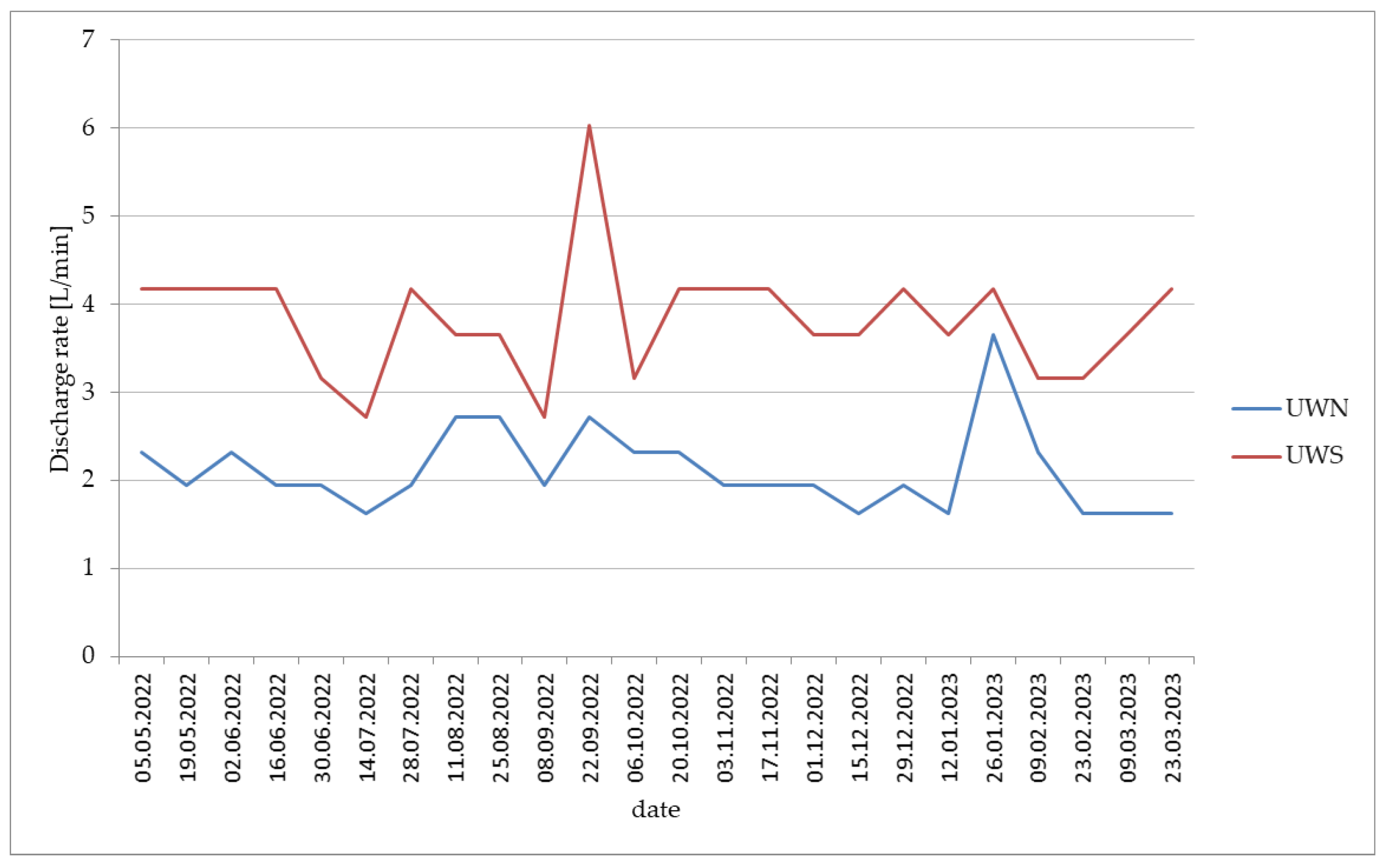
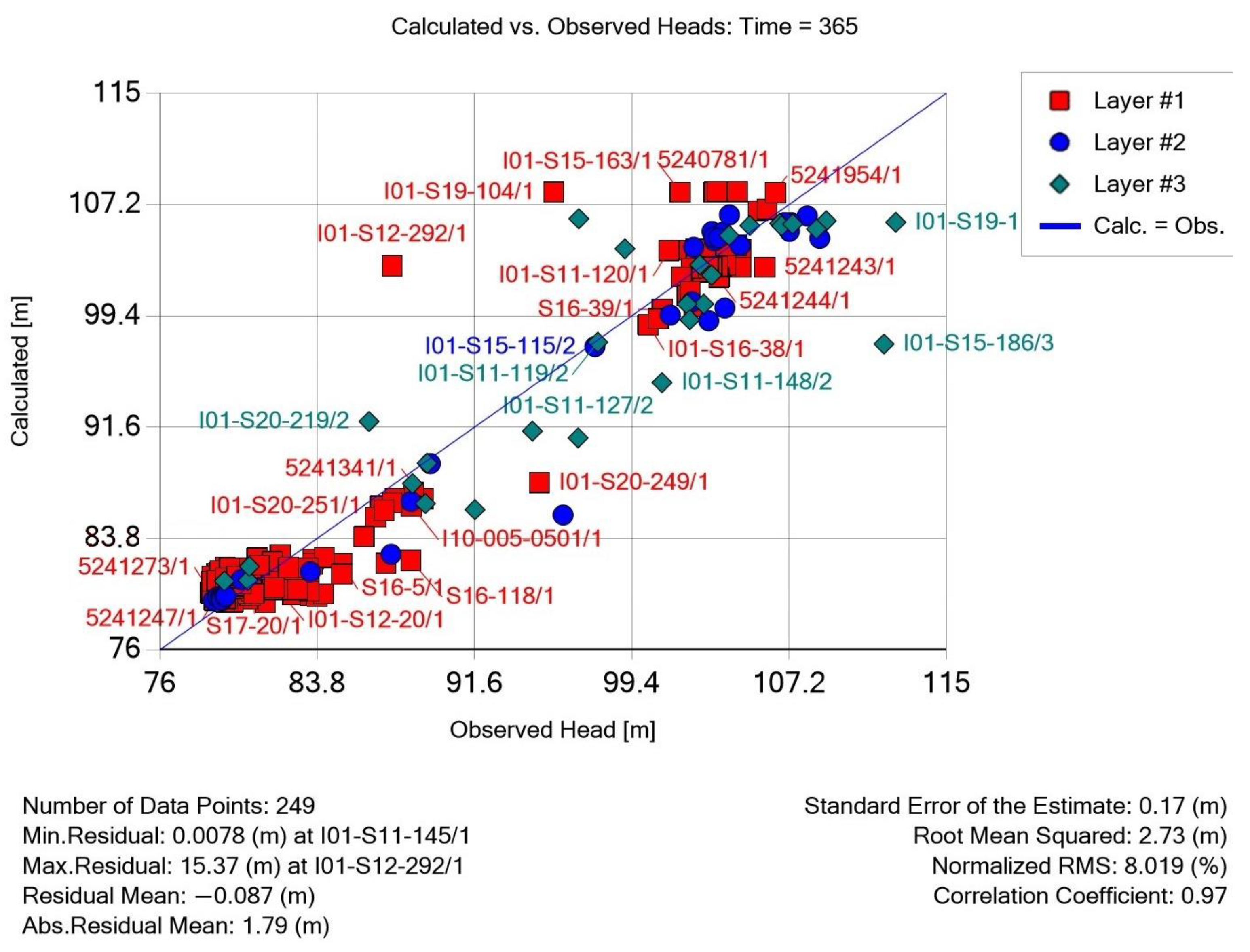

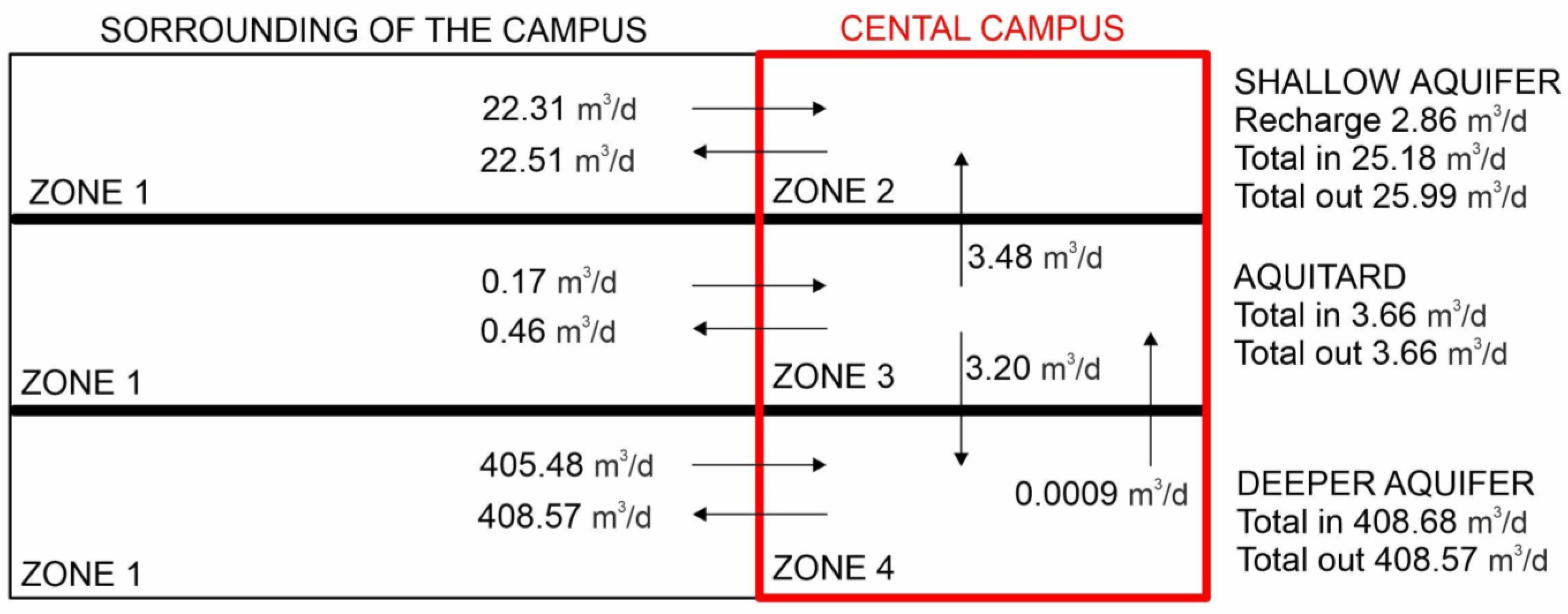
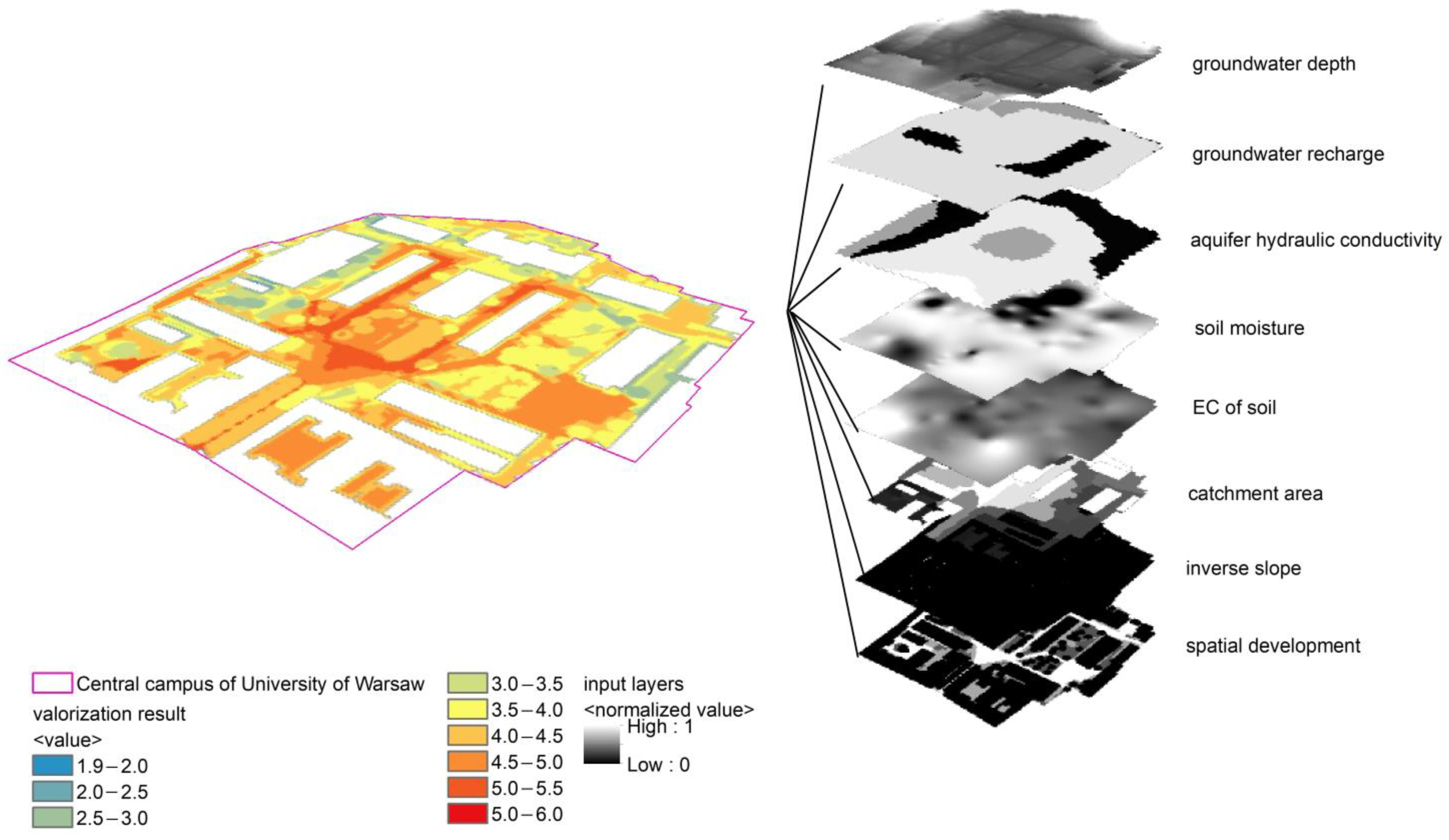
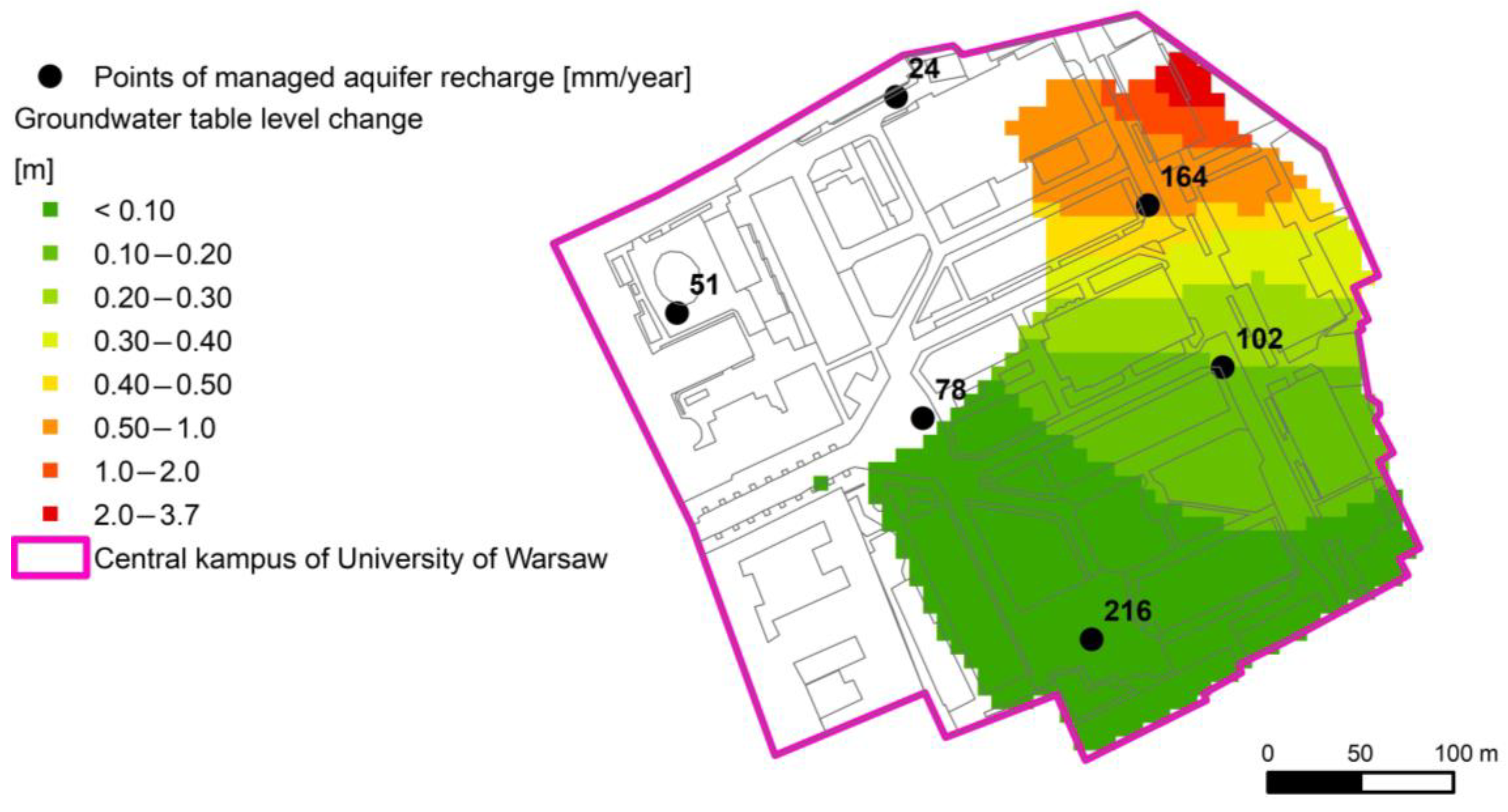
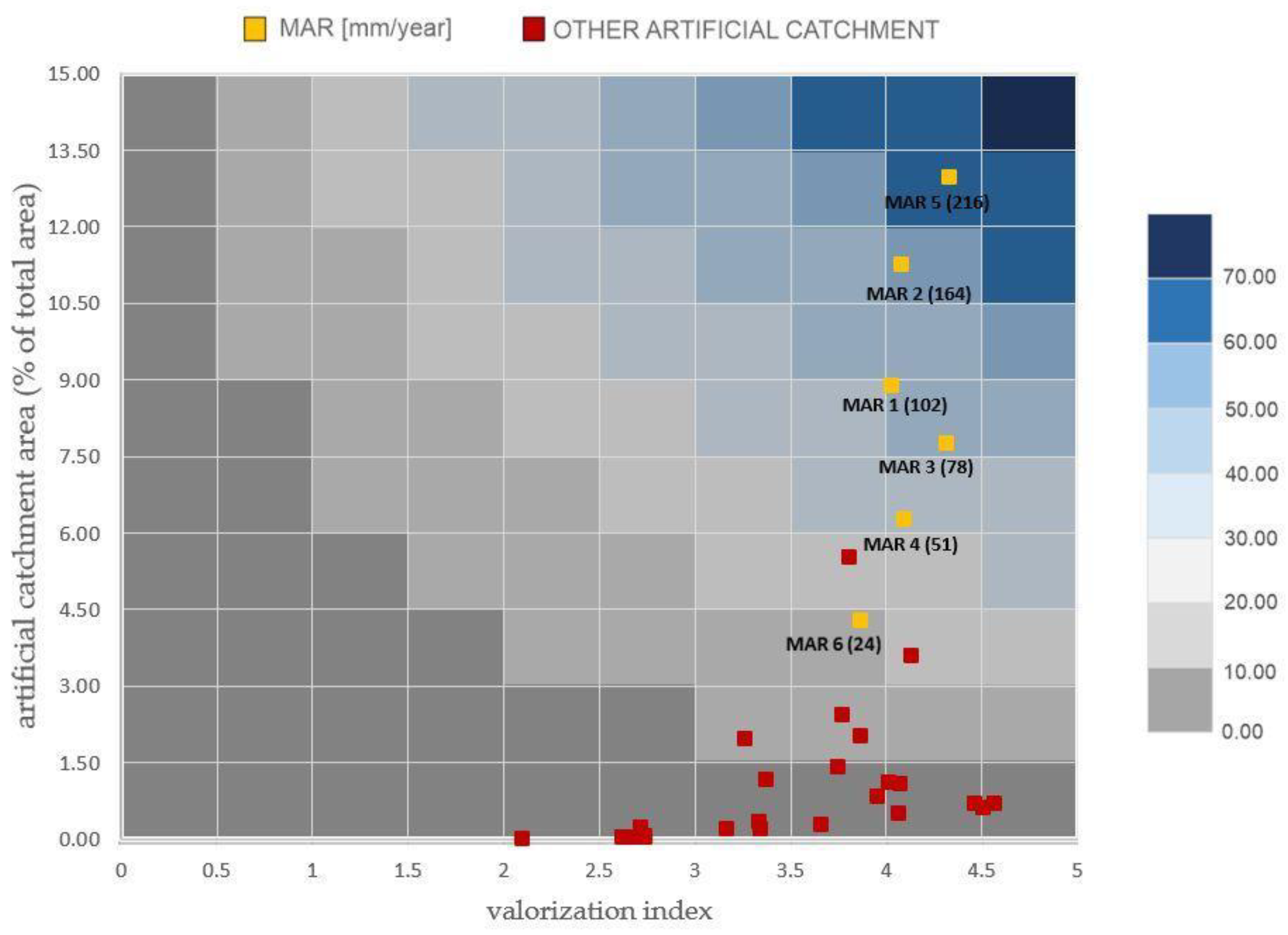
| Type of Research | Scope of Research | Frequency | Period | Data Source |
|---|---|---|---|---|
| Analysis of climatic data | Data from the synoptic station of Warsaw (Station ID 352200375) Precipitation, temperature, water vapor pressure, number of days with precipitation | Monthly sums and averages | January 2007–February 2023 | danepubliczne.imgw.pl/[25] |
| Field studies of the vadose zone | Interval soil moisture measurements and EC of soil by probe Wet-150 at a depth of 10–60 cm | Four profiles in the interval of 2 weeks, 25 measurements each time, 20 of total observation date | June 2022–February 2023 | Own studies |
| Field studies of the vadose zone | Soil moisture measurements and EC of soil by probe Wet-150 at a depth of 10 cm | 116 measurements each time | Tests on 14 July 2022, 8 September 2022, 29 December 2022 | Own studies |
| Laboratory studies of the vadose zone | Soil samples with natural structure from four profiles, from a depth of 10 cm to a depth of 60–70 cm testing the hydraulic conductivity of samples with an Eijkelkamp permeability meter Soil volumetric moisture test—the difference in the mass of soil with natural moisture and dried soil 105–110 °C | 25 samples, one-time test | June 2022 | Own studies |
| Studies of spring discharge rates | Cyclical tests in 2 springs, using the Poncelat method, with verification using the volumetric method | 2-week interval | May 2022–February 2023 | Own studies |
| Studies of groundwater flow | Model with an area of 1.91 km2, 2 aquifers, reverse task to determine the components of the groundwater balance and rainwater infiltration, including the central campus area | - | Steady-state representing average annual groundwater state | Borehole data from databases: CBDH (293 objects), CBGI (444 objects) [24] DEM 1 × 1 m [26] General Geographical Database BDOT 10k [27] |
| Retention Facility No. | Valorization Result | Run-Off Receiving Area [ha] | Volume of Water to be Managed [m3] |
|---|---|---|---|
| 1 | 5.12 | 0.52 | 5.04 |
| 2 | 5.45 | 0.66 | 6.40 |
| 3 | 5.18 | 0.46 | 4.41 |
| 4 | 5.17 | 0.37 | 3.56 |
| 5 | 4.80 | 0.76 | 7.36 |
| 6 | 5.84 | 0.25 | 2.43 |
Disclaimer/Publisher’s Note: The statements, opinions and data contained in all publications are solely those of the individual author(s) and contributor(s) and not of MDPI and/or the editor(s). MDPI and/or the editor(s) disclaim responsibility for any injury to people or property resulting from any ideas, methods, instructions or products referred to in the content. |
© 2025 by the authors. Licensee MDPI, Basel, Switzerland. This article is an open access article distributed under the terms and conditions of the Creative Commons Attribution (CC BY) license (https://creativecommons.org/licenses/by/4.0/).
Share and Cite
Trzeciak, J.; Zabłocki, S. Valorization of Historical Urban Spaces for Managed Aquifer Recharge as a Tool to Support Sustainable Urban Development in Warsaw, Poland. Urban Sci. 2025, 9, 224. https://doi.org/10.3390/urbansci9060224
Trzeciak J, Zabłocki S. Valorization of Historical Urban Spaces for Managed Aquifer Recharge as a Tool to Support Sustainable Urban Development in Warsaw, Poland. Urban Science. 2025; 9(6):224. https://doi.org/10.3390/urbansci9060224
Chicago/Turabian StyleTrzeciak, Joanna, and Sebastian Zabłocki. 2025. "Valorization of Historical Urban Spaces for Managed Aquifer Recharge as a Tool to Support Sustainable Urban Development in Warsaw, Poland" Urban Science 9, no. 6: 224. https://doi.org/10.3390/urbansci9060224
APA StyleTrzeciak, J., & Zabłocki, S. (2025). Valorization of Historical Urban Spaces for Managed Aquifer Recharge as a Tool to Support Sustainable Urban Development in Warsaw, Poland. Urban Science, 9(6), 224. https://doi.org/10.3390/urbansci9060224






